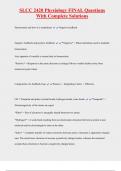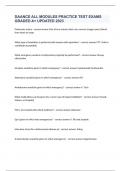Exam (elaborations)
SLCC 2420 Physiology FINAL Questions With Complete Solutions
- Course
- Institution
SLCC 2420 Physiology FINAL Questions With Complete Solutions Homeostasis and how it is maintained Negative feedback Negative feedback and positive feedback *Negative* = Main mechanism used to maintain homeostasis. Acts opposite of variable to return body to homeostasis. *Positive* = Respons...
[Show more]




